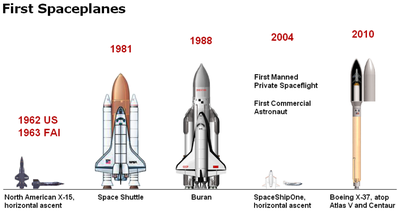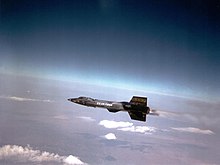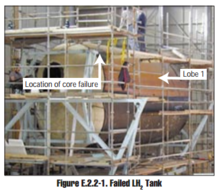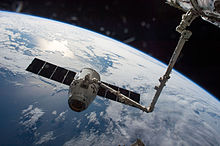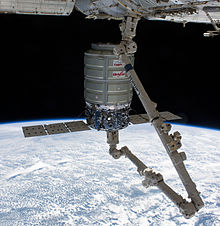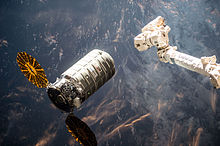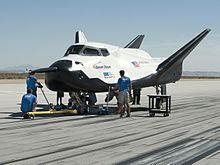A Space Shuttle in orbit around Earth
A spaceplane is an aerospace vehicle that operates as an aircraft in Earth's atmosphere, as well as a spacecraft when it is in space.
It combines features of an aircraft and a spacecraft, which can be
thought of as an aircraft that can endure and maneuver in the vacuum of
space or likewise a spacecraft that can fly like an airplane. Typically,
it takes the form of a spacecraft equipped with wings, although lifting bodies have been designed and tested as well. The propulsion to reach space may be purely rocket based or may use the assistance of airbreathing jet engines. The spaceflight is then followed by an unpowered glide return to landing.
Six kinds of spaceplanes have successfully flown to date, having reentered Earth's atmosphere, returned to Earth, and safely landed — the North American X-15, Space Shuttle, Buran, Boeing X-37, and Scaled Composites' SpaceShipOne and SpaceShipTwo. All six are considered rocket gliders. As of 2019, only these aircraft and conventional rockets have succeeded in reaching space. Three of these six (X-15, SpaceShipOne, and SpaceShipTwo) are rocket-powered aircraft, having been carried up to an altitude of several tens of thousands of feet by an atmospheric mother ship before being released, and then flying beyond the Kármán line
(with the exception of SpaceShipTwo), the internationally-accepted
boundary of Earth's atmosphere, under their own power. Three (Space
Shuttle, Buran, and X-37) are vertical takeoff horizontal landing (VTHL) vehicles relying upon rocket lift for the ascent phase in reaching space and atmospheric lift for reentry, descent and landing.
The three VTHL spaceplanes flew much further than the aircraft launched
ones, not merely leaving Earth's atmosphere but also entering orbit
around it, which requires at least 50 times more energy on the way up
and heavy heat shielding for the trip back. Of the six vehicles, four have been piloted by astronauts, with the Buran and X-37 flying unmanned missions.
Description
Landing of NASA's Space Shuttle Atlantis. The American Space Shuttle orbiters were manned orbital spaceplanes.
Significant features distinguish spaceplanes from traditional spacecraft.
Aerodynamic lift
All aircraft utilize aerodynamic surfaces in order to generate lift. For spaceplanes a variety of wing shapes can be used. Delta wings are common, but straight wings, lifting bodies and even rotorcraft have been proposed. Typically the force of lift generated by these surfaces is many times that of the drag that they induce.
Atmospheric reentry
Because suborbital spaceplanes are designed for trajectories that do not reach orbital speed, they do not need the kinds of thermal protection orbital spacecraft required during the hypersonic phase of atmospheric reentry. The Space Shuttle thermal protection system,
for example, protects the orbiter from surface temperatures that could
otherwise reach as high as 1,650 °C (3,000 °F), well above the melting
point of steel.
Aircraft landing
A spaceplane operates as an aircraft in Earth's atmosphere. Aircraft may land on firm runways, helicopter landing pads, or even water (amphibious aircraft), snow or ice. To land, the airspeed and the rate of descent
are reduced such that the aircraft descends at a slow enough rate to
allow for a gentle touch down. Landing is accomplished by slowing down
and descending. This speed reduction is accomplished by reducing thrust
and/or inducing a greater amount of drag using flaps, landing gear or speed brakes. Splashdown is an easier technical feat to accomplish, requiring only the deployment of a parachute (or parachutes), rather than successfully aviating the atmosphere.
Project Gemini's original concept design was as a spaceplane, with
paraglider and wheels (or skis) attached. However, this concept was
abandoned in favor of parachute splashdowns, because of expensive
technical failures during testing and development. Whereas Project
Gemini's splashdown parachutes took only 5 months to develop in 1963,
Gemini's spaceplane concept failed to materialize even after nearly 3
years of continued development.
Propulsion
Buran orbiter rear showing rocket engine nozzles, for maneuvering in low Earth orbit and thin air
Rocket engines
All spaceplanes to date have used rocket engines with chemical fuels. As the orbital insertion burn has to be done in space, orbital spaceplanes require rocket engines for at least that portion of the flight.
Airbreathing engines
A difference between rocket based and air-breathing aerospace plane
launch systems is that aerospace plane designs typically include minimal
oxidizer storage for propulsion. Air-breathing aerospace plane designs include engine inlets so they can use atmospheric oxygen for combustion. Since the mass of the oxidizer is, at takeoff, the single largest mass of most rocket designs (the Space Shuttle's liquid oxygen tank weighs 629,340 kg, more than one of its solid rocket boosters),
this provides a huge potential weight savings benefit. However, air
breathing engines are usually very much heavier than rocket engines and
the empty weight of the oxidizer tank, and since, unlike oxidizer, this
extra weight (which is not expended to add kinetic energy to the vessel,
as is propellant mass) must be carried into space it may offset the
overall system performance.
Types of air breathing engines proposed for spaceplanes include scramjet, liquid air cycle engines, precooled jet engines, pulse detonation engine and ramjets. Some engine designs combine several types of engines features into a combined cycle. For instance, the Rocket-based combined cycle
(RBCC) engine uses a rocket engine inside a ramscoop so that at low
speed, the rockets thrust is boosted by ejector augmented thrust. It
then transitions to ramjet propulsion at near-supersonic speeds, then to
supersonic combustion or scramjet propulsion, above Mach 6, then back
to pure rocket propulsion above Mach 10.
Harsh flight environment
The
flight trajectory required of air-breathing aerospace vehicles to reach
orbit is to fly what is known as a 'depressed trajectory' which places
the aerospace plane in the high-altitude hypersonic flight regime of the
atmosphere. This environment induces high dynamic pressure, high
temperature, and high heat flow loads particularly upon the leading edge surfaces of the aerospace plane. These loads typically require special advanced materials, active cooling, or both, for the structures to survive the environment.
Rocket-powered spaceplanes also face a significant thermal
environment if they are burning for orbit, but this is nevertheless far
less severe than air-breathing spaceplanes.
Suborbital space planes designed to briefly reach space do not
require significant thermal protection, as they experience peak heating
for only a short time during re-entry. Intercontinental suborbital
trajectories require much higher speeds and thermal protection more
similar to orbital spacecraft reentry.
Center of mass issues
A wingless launch vehicle has lower aerodynamic forces affecting the vehicle, and attitude control
can be active perhaps with some fins to aid stability. For a winged
vehicle the centre of lift moves during the atmospheric flight as well
as the centre of mass; and the vehicle spends longer in the atmosphere
as well. Historically, the X-33 and HOTOL
spaceplanes were rear engined and had relatively heavy engines. This
puts a heavy mass at the rear of the aircraft with wings that had to
hold up the vehicle. As the wet mass reduces, the centre of mass tends
to move rearward behind the centre of lift, which tends to be around the
centre of the wings. This can cause severe instability that is usually
solved by extra fins which add weight and decrease performance.
Flown spaceplanes
World's first spaceplanes: North American X-15, Space Shuttle, Buran, SpaceShipOne, Boeing X-37. The X-15 reached space in 1962/1963 (USAF/FAI Kármán line classifications). SpaceShipOne was piloted by the first commercial astronaut. Both X-15 and SpaceShipOne ascend horizontally from a mother ship. Both Buran and X-37 spaceflights were unmanned. The X-37 launches atop an Atlas V 501 launch vehicle.
Orbital spaceplanes
All three of the orbital spaceplanes successfully flown to date utilize a VTHL (vertical takeoff, horizontal landing) design. They include the piloted United States Space Shuttle and two unmanned spaceplanes: the late-1980s Soviet Buran and the early-2010s Boeing X-37.
The early-1980s BOR-4 (subscale test vehicle for the Spiral spaceplane that was subsequently cancelled) was a spacecraft that did successfully reenter the atmosphere and fly like an aircraft. But it was not designed to sustain atmospheric flight. It was designed to stop flying, open a parachute and then splash in the ocean.
These vehicles have used wings to provide aerobraking to return from orbit and to provide lift, allowing them to land on a runway like conventional aircraft. These vehicles are still designed to ascend to orbit vertically under rocket power like conventional expendable launch vehicles. One drawback of spaceplanes is that they have a significantly smaller payload fraction
than a ballistic design with the same takeoff weight. This is in part
due to the weight of the wings — around 9–12% of the weight of the
atmospheric flight weight of the vehicle. This significantly reduces the
payload size, but the reusability is intended to offset this
disadvantage.
While all spaceplanes have used atmospheric lift for the reentry phase, none to date have succeeded in a design that relies on aerodynamic lift for the ascent phase in reaching space (excluding a mother ship first stage). Efforts such as the Silbervogel and X-30/X-33 have all failed to materialize into a vehicle capable of successfully reaching space. The Pegasus
winged booster has had many successful flights to deploy orbital
payloads, but since its aerodynamic vehicle component operates only as a
booster, and not operate in space as a spacecraft, it is not typically
considered to be a spaceplane.
On the other hand, OREX is a test vehicle of HOPE-X and launched into 450 km LEO using H-II in 1994. OREX succeeded to reenter, but it was only hemispherical head of HOPE-X, that is, not plane-shaped.
Suborbital spaceplanes
The X-15's rocket engine used ammonia and liquid oxygen.
Other spaceplane designs are suborbital, requiring far less energy for propulsion, and can use the vehicle's wings to provide lift for the ascent to space in addition to the rocket. As of 2018, three such crafts flew successfully to and from space, back to Earth, namely the North American X-15 and Virgin Galactic SpaceShipOne and SpaceShipTwo.
All these crafts were not capable of entering orbit and all of them
began their independent flight only after being lifted to high altitude
by a carrier aircraft.
SpaceShipTwo
Scaled Composites and Virgin Galactic unveiled on 7 December 2009, the SpaceShipTwo space plane, the VSS Enterprise, and its WhiteKnightTwo mothership, "Eve". SpaceShipTwo is designed to carry two pilots and six passengers on suborbital flights. On 13 December 2018 SpaceShipTwo VSS Unity successfully crossed the space (above 50 miles altitude) boundary.
HYFLEX was a miniaturized suborbital demonstrator of HOPE-X launched in 1996. HYFLEX flew to 110 km altitude and succeeded in atmospheric reentry, subsequently achieving hypersonic flight. Though HYFLEX achieved a controlled aircraft descent, it was not designed for a planned aircraft landing, the engineers opting instead for a splashdown without a parachute. Recovery of the HYFLEX failed and it sank in the Pacific Ocean.
Proposed spaceplanes
United States Gemini tested the use of a Rogallo wing rather than a parachute. August 1964.
Various types of spaceplanes have been suggested since the early twentieth century. Notable early designs include Friedrich Zander's spaceplane equipped with wings made of combustible alloys that it would burn during its ascent, and Eugen Sänger's Silbervogel bomber design. Also in Germany and then in the US, winged versions of the V-2 rocket were considered during and after World War II, and when public interest in space exploration was high in the 1950s and '60s, winged rocket designs by Wernher von Braun and Willy Ley served to inspire science fiction artists and filmmakers.
United States
The U.S. Air Force invested some effort in a paper study of a variety of spaceplane projects under their Aerospaceplane efforts of the late 1950s, but later ended these when they decided to use a modified version of Sänger's design. The result, Boeing X-20 Dyna-Soar, was to have been the first orbital spaceplane, but was canceled in the early 1960s in lieu of NASA's Project Gemini and the U.S. Air Force's Manned Orbiting Laboratory program.
In 1961, NASA originally planned to have the Gemini spacecraft land on a firm, solid ground runway with a Rogallo wing airfoil, rather than as a splashdown with parachute. The test vehicle became known as the Paraglider Research Vehicle. Development work on both Gemini's splashdown parachute and spaceplane paraglider began in 1963. By December 1963, the parachute was already to undergo full-scale deployment testing. On the other hand, by December 1963 the paraglider spaceplane concept was running into technical difficulties and subsequently became replaced by the parachute splashdown concept. Though attempts to revive Gemini's paraglider spaceplane concept persisted within NASA and North American Aviation as late as 1964, NASA Headquarters Gemini Chief William Schneider discontinued development as technical hurdles became too expensive.
United States STS concepts, circa 1970s
Illustration of NASP taking off
The Rockwell X-30
National Aero-Space Plane (NASP), begun in the 1980s, was an attempt to
build a scramjet vehicle capable of operating like an aircraft and
achieving orbit like the shuttle. President Ronald Reagan described NASP in his 1986 State of the Union
address as "...a new Orient Express that could, by the end of the next
decade, take off from Dulles Airport and accelerate up to twenty-five
times the speed of sound, attaining low Earth orbit or flying to Tokyo
within two hours..."
There were six identifiable technologies which were considered critical
to the success of the NASP project. Three of these "enabling"
technologies were related to the propulsion system, which would consist
of a hydrogen-fueled scramjet.
The NASP program became the Hypersonic Systems Technology Program
(HySTP) in late 1994. HySTP was designed to transfer the
accomplishments made in hypersonic technologies by the National
Aero-Space Plane (NASP) program into a technology development program.
On 27 January 1995 the Air Force terminated participation in (HySTP). It was canceled due to increasing technical challenges, and growing budgets.
In 1994 Mitchell Burnside Clapp proposed a single stage to orbit peroxide/kerosene spaceplane called "Black Horse". It was to take off almost empty and undergo mid-air refueling before launching to orbit.
The Lockheed Martin X-33 was a 1/3 scale prototype made as part of an attempt by NASA to build a SSTO hydrogen-fuelled spaceplane VentureStar that failed when the hydrogen tank design proved to be unconstructable in the planned way.
The edition of 5 March 2006 of Aviation Week & Space Technology
published a story purporting to be "outing" a highly classified U.S.
military two-stage-to-orbit spaceplane system with the code name Blackstar, SR-3/XOV among other nicknames.
Boeing X-37B being prepared for launch in 2010 on an expendable orbital rocket
In 1999 NASA started the Boeing X-37 project, an unmanned, remote controlled spaceplane. The project was transferred to the U.S. Department of Defense in 2004.
Boeing has proposed that a larger variant of the X-37B, the X-37C could be built to carry up to six passengers up to LEO. The spaceplane would also be usable for carrying cargo, with both upmass and downmass
(return to Earth) cargo capacity. The ideal size for the proposed
derivative "is approximately 165 to 180 percent of the current X-37B."
In December 2010, Orbital Sciences made a commercial proposal to NASA to develop the Prometheus, a lifting-body spaceplane vehicle about one-quarter the size of the Space Shuttle, in response to NASA's Commercial Crew Development (CCDev) phase 2 solicitation. The vehicle would be launched on a human-rated (upgraded) Atlas V rocket but would land on a runway.
For the same solicitation, Sierra Nevada Corporation proposed phase 2 extensions of its Dream Chaser spaceplane technology, partially developed under the first phase of NASA's CCDev program. Both the Orbital Sciences proposal and the Dream Chaser are lifting body designs. Sierra Nevada will utilize Virgin Galactic to market Dream Chaser commercial services and may use "Virgin's WhiteKnightTwo carrier aircraft as a platform for drop trials of the Dream Chaser atmospheric test vehicle"
NASA expects to make approximately $200 million of phase 2 awards by
March 2011, for technology development projects that could last up to 14
months.
Soviet Union and Russia
Buran orbiter being transported via An-225
The Soviet Union firstly considered a preliminary design of rocket-launch small spaceplane Lapotok in early 1960s. Then the Spiral airspace system with small orbital spaceplane and rocket as second stage was widely developed in the 1960s–1980s. Mikoyan-Gurevich MiG-105 was a manned test vehicle to explore low-speed handling and landing.
Cosmoplane
In recent times, an orbital spaceplane, called cosmoplane (Russian: космоплан)
capable of transporting passengers has been proposed by Russia's
Institute of Applied Mechanics. According to researchers, it could take
about 20 minutes to fly from Moscow to Paris, using hydrogen and oxygen-fueled engines.
United Kingdom
The Multi-Unit Space Transport And Recovery Device (MUSTARD) was a concept explored by the British
Aircraft Corporation (BAC) around 1968 for launching payloads weighing
as much as 2,300 kg (5,000 lb) into orbit. It was never constructed. The British Government also began development of a SSTO-spaceplane, called HOTOL, but the project was canceled due to technical and financial issues.
The lead engineer from the HOTOL project has since set up a private company dedicated to creating a similar plane called Skylon with a different combined cycle rocket/turbine precooled jet engine called SABRE. This vehicle is intended to be capable of a single stage to orbit launch carrying a 15,000 kg (33,000 lb) payload into low Earth orbit. If successful it would be far in advance of anything currently in operation.
The British company Bristol Spaceplanes has undertaken design and prototyping of three potential spaceplanes since its founding by David Ashford in 1991. The European Space Agency has endorsed these designs on several occasions.
France and the European Space Agency
France worked on the Hermes manned spaceplane launched by Ariane rocket in the late 20th century, and proposed in January 1985 to go through with Hermes development under the auspices of the ESA. Hopper
was one of several proposals for a European reusable launch vehicle
(RLV) planned to cheaply ferry satellites into orbit by 2015. One of those was 'Phoenix', a German project which is a one-seventh scale model of the Hopper concept vehicle. The suborbital Hopper was a FESTIP (Future European Space Transportation Investigations Programme) system study design A test project, the Intermediate eXperimental Vehicle (IXV), has demonstrated lifting reentry technologies and will be extended under the PRIDE programme.
The FAST20XX
Future High-Altitude High Speed Transport 20XX aims to establish sound
technological foundations for the introduction of advanced concepts in
suborbital high-speed transportation with air-launch-to-orbit ALPHA
vehicle.
Japan
HOPE was a Japanese experimental spaceplane project designed by a partnership between NASDA and NAL (both now part of JAXA), started in the 1980s. It was positioned for most of its lifetime as one of the main Japanese contributions to the International Space Station, the other being the Japanese Experiment Module.
The project was eventually cancelled in 2003, by which point test
flights of a sub-scale testbed had flown successfully. As of 2018, Japan
is developing the Winged Reusable Sounding rocket (WIRES), which if successful, may be used as a recoverable first-stage or as a crewed sub-orbital spaceplane.
Germany
After the German Sänger-Bredt RaBo and Silbervogel of the 1930s and 1940s, Eugen Sänger worked for time on various space plane projects, coming up with several designs for Messerschmitt-Bölkow-Blohm such as the MBB Raumtransporter-8. In the 1980s, West Germany funded design work on the MBB Sänger II
with the Hypersonic Technology Program. Development continued on
MBB/Deutsche Aerospace Sänger II/HORUS until the late 1980s when it was
canceled. Germany went on to participate in the Ariane rocket, Columbus
space station and Hermes spaceplane of ESA, Spacelab of ESA-NASA and Deutschland
missions (non-U.S. funded Space Shuttle flights with Spacelab). The
Sänger II had predicted cost savings of up to 30 percent over expendable
rockets. The Daimler-Chrysler Aerospace RLV was a much later small reusable spaceplane prototype for ESA Future Launchers Preparatory Programme/FLTP program.
Most recent project is SpaceLiner.
India
AVATAR (Aerobic Vehicle for Hypersonic Aerospace Transportation; Sanskrit: अवतार) was a concept study for an unmanned single-stage reusable spaceplane capable of horizontal takeoff and landing, presented to India's Defence Research and Development Organisation. The mission concept was for low cost military and commercial satellite launches. No further studies or development have taken place since 2001.
As of 2016, the Indian Space Research Organisation is developing a launch system named the Reusable Launch Vehicle (RLV). It is India's first step towards realizing a two-stage-to-orbit reusable launch system. A space plane serves as the second stage. The plane is expected to have air-breathing scramjet engines as well as rocket engines. Tests with miniature spaceplanes and a working scramjet have been conducted by ISRO in 2016.
China
Shenlong (Chinese: 神龙; pinyin: shén lóng; literally: 'divine dragon') is a proposed Chinese robotic spaceplane that is similar to the American Boeing X-37. Only a few images have been released since late 2007.



